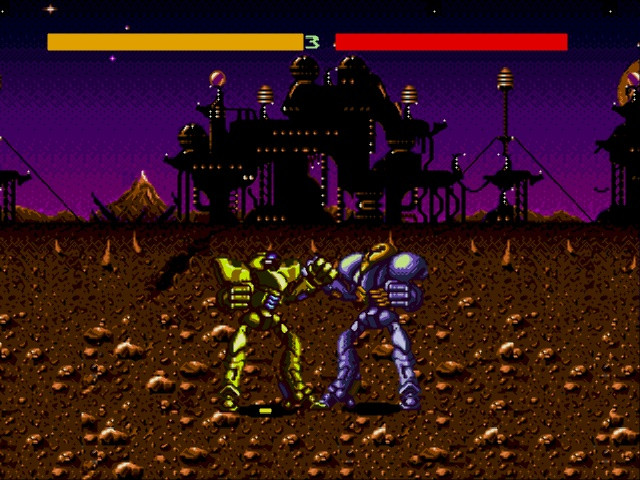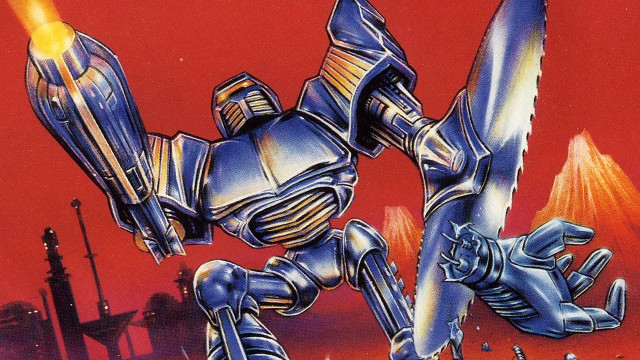Thanks to GameRevolution reader sli’s suggestion on our forums, we’ve decided to embark upon a new series here on GR. Every Thursday, ‘Remember?‘ will explore an old game that conjures up pleasant (or in some cases, not so pleasant) memories for our GR staff. This week our Executive Editor Paul Tamburro looks at Cyborg Justice, an underrated classic for the Sega Genesis.
We frequently talk about how certain game genres are “over-saturating the market,” but does anyone remember the Sega Genesis in the ’90s? If you weren’t a fan of running to the right and hitting things, then oh boy were you going to have a tough time finding games that appealed to you on that console. While Nintendo was off green-lighting RPGs, puzzle games and even a bloody ant colony management game, the Genesis — the console marketed to your cooler, more handsome older brother — just wanted you to run, jump and blow shit up.
But while many of these derivative games fell by the wayside, one stuck in my memory far longer than it perhaps should have: Cyborg Justice. Developed by the now-defunct Novotrade (whose last game was 2006’s ridiculous shark ’em up Jaws Unleashed), Cyborg Justice was one of those games that struck an inexplicable chord with me at a young age, despite it seemingly having resonated with no one else at the time.

Buying games in the ’90s was a risky but exciting endeavor. Without the internet giving you every possible opinion about an upcoming video game until you feel like you’ve completed it before you’ve even played it, your judgement in the ’90s was either based upon one review from a guy in a magazine, word of mouth from your friends (who, in my case, routinely had terrible opinions — one of them would only ever let you play The Lawnmower Man when you visited his house) or just because its box looked cool. Cyborg Justice fell into the latter camp for me, with its giant, metallic robot thrusting its circular saw arm into the foreground, all while simultaneously blasting bullets out of its other arm against an apocalyptic red backdrop. “Fuck yeah,” I thought to myself, except I was 8 years old so it was probably more like “heck yeah.”
Also: If Single-Player Games Are “Dying” Then Explain Super Mario Odyssey
The main hook of Cyborg Justice was that you could fully customize your robot, equipping them with a variety of weaponry and abilities to take with you onto its side-scrolling battlefield. You could put on pneumatic frog-like legs that allowed you to cover large distances with your jumps, attach tank tracks that saw you rolling through your enemies, or you could throw a chainsaw onto your arm and slice through them like they were a leg of ham. I remember reading the back of its box prior to buying it back in the day, seeing the note about customizing your robots and being in utter disbelief that this would be a possibility. I told my two cousins and we agreed that, while awesome in theory, there was no way Cyborg Justice was going to allow us to make our very own robots. But an hour later there we were, running around with our customized death machines, living our best lives.

Whereas most beat ’em up games have you trouncing a bunch of underwhelming henchmen until you come across an appropriately tough boss, Cyborg Justice differentiated itself from other games in the genre by way of having you face off against other customized robots, who each shared your abilities and were almost as powerful as both you and your co-op buddy. As such every fight in the game had the potential to cut you down, with the AI being more than equipped to handle your attacks and respond accordingly.
Cyborg Justice balanced the potentially overwhelming strength of your enemies by allowing you to dismember them, an action that would reward you with a reasonable amount of health in return. Allowing yourself the space and the time to pull this off was difficult, with its two-player mode routinely requiring you to assign one player as the distraction, while the other worked on regenerating their health. Mostly every set of enemies came in pairs, making each fight feel like you were taking part in a robotic tag team match.
Looking back, it’s surprising just how much depth Cyborg Justice had tucked away inside of it when compared with its more popular peers. Whereas most beat ’em ups didn’t get much more complicated than a combo string located on the same button, or being able to pick up a broken bottle from the floor and use it as a weapon, Cyborg Justice had genuine fighting game combos packed into it. Couple these with moves that could stun your opponents, weapon-specific attacks and the ability to literally tear enemies’ torsos from off of their legs and reassemble them at the player’s own discretion, then it’s perhaps not that shocking that it didn’t reach a wider audience.
Though it absolutely deserved more recognition than it received back in the day, its complicated mechanics were certainly more of a handful than what was seen in the likes of Streets of Rage & co, arguably lending to its relative obscurity. With that being said, if you get the opportunity to play Cyborg Justice now it has definitely withstood the test of time, so you should definitely seek it out.







